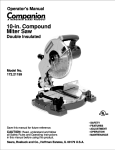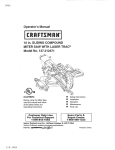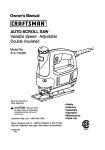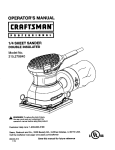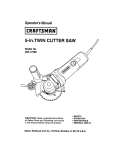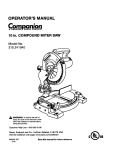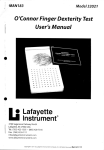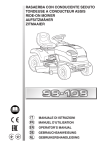Download COMPANION 320.10189 Operator`s manual
Transcript
Operator's Manual Companion 1/4-Sheet Palm-Grip Sander Single Speed Model No. 320.10189 ,'_CAUTION: Read, understand and follow all Safety Rules and Operating Instructions in this manual before using this product. Sears, Roebuck and Co., Hoffman • SAFETY • OPERATION • MAINTENANCE Estates, IL 60179 U.S.A. Warranty ......................................................... Rules for Safe Operation ..................................... Safety Symbols ................................................. Unpacking ....................................................... Description ....................................................... Operation ......................................................... Maintenance ..................................................... Troubleshooting ................................................ Accessories ...................................................... Service Numbers ............................................... Page 2 Page 3 Page 7 Page 8 Page 8 Page 9 Page 15 Page 16 Page 17 Back Cover ONE FULLYEAR WARRANTY ON COMPANION 1/4-SHEET PALM-GRIP SANDER If this Companion Sander fails due to a defect in material or workmanship within one year from the date of purchase, RETURN ITTO THE NEAREST SEARS STORE IN THE UNITED STATES, and Sears will replace it, free of charge. This warranty is void if this tool is used for commercial or rental purposes. This warranty gives you specific legal rights, and you may also have other rights which vary from state to state. Sears, Roebuck and Co., Dept.817WA, Hoffman Estates, IL 60179 SAVE THESE INSTRUCTIONS! READ ALL INSTRUCTIONS! WORK AREA SAFETY 1. ALWAYS keep your work area clean and well lit. Cluttered benches and dark areas invite accidents. 2. DO NOT operate power tools in explosive atmospheres, such as in the presence of flammable liquids, gases, or dust. Power tools create sparks which may ignite the dust or fumes. 3. ALWAYS keep bystanders, children and visitors away while operating a power tool. Distractions can cause you to lose control. ELECTRICAL SAFETY 1. Double insulated tools are equipped with a polarized plug (one blade is wider than the other.) This plug will fit in a polarized outlet only one way. If the plug does not fit fully in the outlet, reverse the plug. If it still does not fit, contact a qualified electrician to install a polarized outlet. Do not change the plug in any way. 2. Double insulation rDleliminates the need for the three-wire grounded power cord and grounded power supply system. Applicable only to Class II (double insulated) tools. 3. Before plugging in the tool, BE SURE that the outlet voltage supplied is within the voltage marked on the tool's data plate. DO NOT use "AC only" rated tools with a DC power supply. 4. ALWAYS avoid body contact with grounded surfaces, such as pipes, radiators, ranges and refrigerators. There is an increased risk of electric shock if your body is grounded. 5. If operating the power tool in damp locations is unavoidable, ALWAYS use a Ground Fault Circuit Interrupter to supply power to your tool. ALWAYS wear electrician's rubber gloves and footwear in damp conditions. 6. DO NOT expose power tools to rain or wet conditions. Water entering a power tool will increase the risk of electric shock. 7. DO NOT abuse the cord. NEVER use the cord to carry the tools or pull the plug from the outlet. Keep cord away from heat, oil, sharp edges or moving parts. Replace damaged cords immediately. Damaged cords increase the risk of electric shock. 8. When operating a power tool outside, ALWAYS use an outdoor extension cord marked "W-A" or "W". These cords are rated for outdoor use and reduce the risk of electric shock. NOTE: The extension cord must have adequate wire size AWG (American Wire Gauge) for safe, efficient use. Smaller gauge wires have greater capacity (16 gauge wire has more capacity than 18 gauge wire). I I I I SAFETY SYMBOLS TOOL USE AND CARE SAFETY The purpose of safety symbols is to attract your attention to possible dangers. The safety symbols, and the explanations with them, deserve your careful attention and understanding. The safety warnings DO NOT by themselves eliminate any danger. The instructions and warnings they give are no substitutes for proper accident prevention measures. 1. ALWAYS use clamps or other practical ways to secure and support the workpiece to a stable platform. Holding the work by hand or against your body is unstable and may lead to loss of control. SYMBOL MEANING Z_ SAFETY ALERT SYMBOL: with Indicates or caution. May be used in conjunction other danger, symbols warning or pictographs. A DANGER: Failure to obey a safety warning will result in serious injury to yourself or to others. Always follow the safety precautions to reduce the risk of fire, electric shock and personal injury. A WARNING: Failure cansafety result precautions in serious to injury to yourself or to to obey others.a safety Alwayswarning follow the reduce the risk of fire, electric shock and personal injury. /k CAUTION: Failure to obey a safety warning may result in property damage or personal injury to yourself or to others. Always follow the safety precautions to reduce the risk of fire, electric shock and personal injury. NOTE: Advises you of information or instructions vital to the operation or maintenance of the equipment. PERSONAL SAFETY 1. ALWAYS stay alert, watch what you are doing and use common sense when operating a power tool. DO NOT use tool while tired or under the influence of drugs, alcohol or medication. A moment of inattention while operating power tools may result in serious personal injury. 2. ALWAYS dress properly. DO NOT wear loose clothing or jewelry. Pull back long hair. Keep your hair, clothing and gloves away from moving parts. Loose clothes, jewelry or long hair can be caught in moving parts. 3. ALWAYS avoid accidental starting. BE SURE switch is in the "Off" position before plugging in. DO NOT carry tools with your finger on the switch. Carrying tools with your finger on the switch or plugging in tools that have the switch in the "On" position invites accidents. 4. ALWAYS remove adjusting keys or wrenches before turning the tool "On". A wrench or a key that is left attached to a rotating part of the tool may result in personal injury. 5. DO NOT overreach. ALWAYS keep proper footing and balance at all times. Proper footing and balance enables better control of the tool in unexpected situations. 6. ALWAYS use safety equipment. Always wear eye protection. 2. DO NOT force tool. Use the correct sandpaper for your application. The correct tool and sandpaper will do the job better and safer at the rate for which it is designed. 3. DO NOT use tool if switch does not turn it "On" or "Off". Any tool that cannot be controlled with the switch is dangerous and must be repaired. 4. ALWAYS disconnect the plug from the power source before making any adjustments, changing accessories or storing the tool. Such preventive safety measures reduce the risk of starting the tool accidentally. 5. ALWAYS store idle tools out of reach of children and other untrained persons. Tools are dangerous in the hands of untrained users. 6. ALWAYS maintain tools with care. Keep cutting tools sharp and clean. Properly maintained tools with sharp cutting edges are less likely to bind and are easier to control. 7. ALWAYS check for misalignment or binding of moving parts, breakage of parts and any other condition that may affect the tool's operation. If damaged, have the tool serviced before using. Many accidents are caused by poorly maintained tools. 8. ALWAYS use only accessories that are recommended for this tool. Accessories that may be suitable for one tool may become hazardous when used on another tool. 9. Use only accessories recommended for this tool that are sold by Sears or a Craftsman outlet. Use of any accessories purchased elsewhere may be hazardous. SAFETY RULES FOR SANDERS ! I Do Z_ not DANGER! reach into Keep the immediate hands away work from area. immediate work area and sandpaper. 1. ALWAYS keep your body positioned to either side of the sander, but not in line with it. 2. DO NOT reach near the work. The sandpaper is exposed at all times. 3. ALWAYS clamp workpiece before sanding. Never hold a workpiece in your hand or legs. Small or thin material may flex or vibrate with the sander, causing loss of control. 4. NEVER touch the sandpaper after use. It may be hot after prolonged use. 5. ALWAYS hold tool by insulated gripping surfaces when performing an operation where the tool may contact hidden wiring or its own cord. Contact with a "live" wire will make the exposed metal parts of the tool "live" and shock the operator. 6. ALWAYS use sandpaper that has the correct size, shape and sanding surface. Sandpaper that does not match the size of the sanding platen of the sander will perform erratically and will cause loss of control. 7. ALWAYS BE SURE that all adjustments have been made and that the sandpaper is fastened tightly BEFORE sanding. Loose sandpapers can cause the tool to slip, and loss of control may result. I I ADDITIONAL RULES FOR SAFE OPERATION cont. ADDITIONAL I before using the sander. Failure to follow all instructions may result in hazardous I radiation AWARNING: SUREshock, to read understand instructions exposure, BE electric fireand and/or serious all personal injury.in this manual WEAR YOUR I I 1. Know your power tool. Read this operator's manual carefully. Learn the applications and limitations, as well as the specific potential hazards related to this tool. Following this rule will reduce the risk of electric shock, fire or serious injury. 2. ALWAYS wear safety glasses or eye shields when using this sander. Everyday eyeglasses have only impact-resistant lenses; they are NOT safety glasses. Following this rule will reduce the risk of serious personal injury. 3. ALWAYS protect your lungs. Wear a face mask or dust mask if the operation is dusty. Following this rule will reduce the risk of serious personal injury. 4. ALWAYS protect your hearing. Wear hearing protection during extended periods of operation. Following this rule will reduce the risk of serious personal injury. 5. ALWAYS inspect the tool cords periodically and if damaged have them repaired at your nearest Sears Service Center or other Authorized Service Facility. ALWAYS be aware of the cord location. Following this rule will reduce the risk of electric shock or fire. 6. ALWAYS check for damaged parts. Before further use of the tool, a guard or other part that is damaged should be carefully checked to determine if it will operate properly and perform its intended function. Check for misalignment or binding of moving parts, breakage of parts and any other condition that may affect the tool's operation. A guard or other part that is damaged should be properly repaired or replaced at a Sears Service Center. Following this rule will reduce the risk of electric shock, fire or serious injury. 7. DO NOT abuse the cord. NEVER use the cord to carry the tool or pull the plug from the outlet. Keep cord away from heat, oil, sharp edges or moving parts. Replace damaged cords immediately. Damaged cords increase the risk of electric shock. Following this rule will reduce the risk of electric shock or fire. 8. ALWAYS make sure that your extension cord is in good condition. When using an extension cord be sure to use one that is heavy enough to carry the current that your tool will draw. A wire gauge (AWG) of at least 14 is recommended for an extension cord 25 feet or less in length. When working outdoors, ALWAYS use an extension cord that is suitable for outdoor use. The cord's jacket will be marked WA. Smaller gauge wires, have greater capacity (16 gauge wire has more capacity than 18 gauge wire). An undersized cord will cause a drop in line voltage, resulting in loss of power and overheating. 9. ALWAYS inspect and remove all nails from lumber before sanding. Following this rule will reduce the risk of serious personal injury. 10. DO NOT use the tool while tired or under the influence of drugs, alcohol or any medication. Following this rule will reduce the risk of electric shock, fire or serious personal injury. 11. SAVE THESE INSTRUCTIONS. Refer to them frequently and use them to instruct others who may use this tool. If someone borrows this tool, make sure they have these instructions also. RULES FOR SAFE OPERATION cont. z_WARNING: The operation of any electric tool can result in foreign objects being thrown into your eyes, which can result in severe eye damage. Before beginning power tool operation, ALWAYS wear safety goggles or safety glasses with side shield and a full face shield when needed. We recommend A Wide Vision Safety Mask for use over eyeglasses or standard safety glasses with side shield, available at Sears Retail Stores. ,,!k WARNING: Some dust particles created by power sanding, sawing, grinding, drilling and other construction jobs contains chemicals known to cause cancer, birth defects or other reproductive harm. Some examples of these chemicals are: • Lead from lead-based paints. • Crystalline silica from bricks and cement and other masonry products. • Arsenic and chromium from chemically-treated lumber. Your risk from these exposures varies, depending upon how often you do this type of work. To reduce your exposure to these chemicals: • Work in a well-ventilated area. • Work with approved safety equipment, such as those dust masks that are specially designed to filter out microscopic particles. The label on your tool may include the following symbols. V.................................................................... Volts A................................................................... Amperes Hz ................................................................. Hertz W.................................................................. Watts min ............................................................... Minutes ................................................................ Alternating current no ................................................................ No-load speed [] ................................................................. Class II construction RPM ............................................................. Revolutions or Strokes per minute Z_ ......................................................... Indicates danger, warning or caution. It means attention! Your safety is involved. IMPORTANT! READ ALL INSTRUCTIONS Yoursander hasbeenshipped completely assembled except fordustbag.Inspect thetoolcarefully tomakesurethatnobreakage ordamage hasoccurred during shipping. Ifanypartsaredamaged ormissing, return theelectric drilltoyournearest Sears Storetohaveit replaced. Thedustbag,sandpaper, paperpunchpadandthis owner's manual arealsoincluded inthiscarton. I missing parts are replaced. Failure to do so could result in possible serious If any parts are missing, DO NOT operate this tool until the I/ixpersonal WARNING: injury. I I /iX WARNING: Your sander should NEVER be connected to a power source when you are assembling parts, making adjustments, installing or removing sandpaper, cleaning or when it is not in use. Disconnecting the tool will prevent accidental starting that could cause serious personal injury. KNOWYOUR SANDER (See Fig.l) Before attempting to use your sander, familiarize yourself with all operating features and safety requirements. Your sander has many built-in convenience features for fast, efficient sanding. Your sander has a comfortable palm-grip handle that provides maximum one-hand control and comfort. It has been designed to reduce operator fatigue during extended periods of continuous sanding operations. Quick-action paper clamps aid removal of sandpaper. A built-in dust collection system collects dust through holes punched in the sandpaper and sanding pad. The dust bag installs and removes easily. Z_ WARNING: BE SURE to read and understand all instructions in this manual before using this sander. Failure to follow all instructions may result in hazardous radiation exposure, electric shock, fire and/or serious personal injury. Fig. 1 ON/OFF rocker switch and switch guard Power cord Includes 24 1/4 sheets of assorted sandpaper I'J 1[,] D]I[_ i [.'] "J:[o] I g [_-_ / [,] _[.'] Input 1.7 Amps No-load speed 12000 OPM (Orbits per Minute) Rating Platen 120 volts, 60Hz AC Cord length ON/OFF rocker switch 6 ft. (1.83 m) For 1/4 sheet of sanding paper Single-speed with switch guard APPLICATIONS (Use only for the purposes listed below) • Sanding wood surfaces • Speed stock removal • Removing lacquer, varnish and other surface coatings • Removing rust from and sanding steel surfaces I when replacing sandpaper, cleaning or when not in use. Disconnecting the I./K. WARNING: your sander fromserious the power source sander will prevent ALWAYS accidental disconnect starting that could cause personal injury. To turn the sander ON, press the ON/OFF rocker switch (see Fig. 1, page 8). To turn the sander OFE press the ON/OFF rocker switch in the opposite direction. I /iX WARNING: ALWAYS wear safety goggles or safety glasses with side shields when operating your sander. Failure to do so could result in foreign objects being thrown into your eyes resulting in possible serious eye damage. I /iX WARNING: ALWAYS wear an appropriate protection when using your sander. dust mask and hearing moving under the sander while being sanded. Unsecured workpiece could be Paper t Dust collecting port Paper clamp Cushion I ON-OFF ROCKER SWITCH I L_ CAUTION! otherwiseinjury. secure your workpiece to prevent it from thrown toward the Clamp operatoror causing Dust bag I I I I INSTALLING INSTALLING SANDPAPER The cushioned pad on the platen allows you to use either non-adhesive sandpaper that clamps to the platen or adhesive-backed sandpaper with pressure-sensitive adhesive backing that sticks to the cushion. INSTALLING NON-ADHESIVE SANDPAPER (see Fig. 2) cont. 4. Position sandpaper, making sure front edge of sandpaper is aligned with front edge of the cushion. Then carefully press sticky side of sandpaper on cushion. Note: Sandpaper must be aligned with the front edge of the cushion for proper functioning of the flush sanding feature. when installing sandpaper, cleaning or when not in use. Disconnecting the ./_ WARNING: your sander from the power source sander will prevent ALWAYS accidental disconnect starting that could cause serious personal injury. I I Fig. 2 Note: The cushion on your sander is approximately 1/4 in. smaller than precut adhesive-backed sanding sheets. If desired, you may want to trim off the overhang of sandpaper on the back side on of cushion. The cushion has been made smaller so that multiple sheets of non-adhesive sandpaper can be installed. PAPER PUNCH (see Fig. 3) A paper punch template has been supplied with your sander. It should be used for aligning and punching holes in the sandpaper for alignment with the holes in the cushion. Punching the holes properly is a necessary step in order for the dust-collection feature of your sander to function properly. 4. Lift up on lever and lock into place. Apply downward pressure to conform sandpaper to platen. 5. Wrap sandpaper around cushion. Lift lever on opposite end of sander and insert loose end of sandpaper under the paper clamp. Fit sandpaper against cushion as tightly as possible. 6. Lift up on lever and lock into place. INSTALLING SANDPAPER 2. Remove old adhesive sandpaper by peeling it off cushion. If replacing regular sandpaper, release paper clamp by lifting up on lever and disengaging it from the tab on the platen. Remove non-adhesive sandpaper. 3. Carefully peel adhesive backing from new 1/4 sheet adhesive sandpaper. Inspect sandpaper before installing. DO NOT use if broken or defective. 1. Unplug your sander. 2. If replacing sandpaper, remove old sandpaper. To remove sandpaper, release paper clamp by lifting up on the lever and disengaging it from the tab on the platen. 3. Insert end of new 1/4 sheet sandpaper approximately 1/2 in. under the paper clamp. ADHESIVE ,4", WARNING: ALWAYS wear safety goggles or safety glasses with side shields when operating your sander. Failure to do so could result in foreign objects being thrown into your eyes resulting in possible serious eye damage sandpaper unlocked position Cushion Tab Fig. : Paper clamp Orient paper punch as shown protection A WARNING: when using ALWAYS your sander. wear an appropriate ADHESIVE SANDPAPER Inspect sandpaper before installing. DO NOT use if broken or defective. 1. Unplug your sander. when installing sandpaper, cleaning or when not in use. Disconnecting the Z_ WARNING: yourcould sander fromserious the power source sander will prevent ALWAYS accidental disconnect starting that cause personal injury. 10 SANDPAPER I [ dust mask and hearing SELECTION TIPS Selecting the correct size grit and type sandpaper is an extremely important step in achieving a high-quality sanded finish. Aluminum oxide, silicon carbide, and other synthetic abrasives are best for power sanding. Natural abrasives, such as flint and garnet, are too soft for economical use in power sanding. In general, coarse grit will remove the most material and finer grit will produce the best finish in all sanding operations. The condition of the surface to be sanded will determine which grit will do the job. If the surface is rough, start with a coarse grit and sand until the surface is uniform. Medium grit may then be used to remove scratches left by the coarser grit. Finer grit is used for finishing the surface. Always continue sanding with progressively finer grit sandpapers until surface is uniform. Note: Do not use sander without sandpaper. Doing so will damage the cushion. 11 I GENERAL SANDING TIPS DO NOT USE THIS OR ANY POWER SANDER FOR WET SANDING OR LIQUID POLISHING. Failure to comply can result in electrical shock causing serious injury. Z_ WARNING: Have you read "RULES FOR SAFE OPERATION", on pages 3 through 7 Operator's Manual? If not, please do it now before you operate this sander. Your safety depends on it! Every time you use the sander, be sure to verify the following: 1. Power cord is not damaged. 2. Sandpaper is the correct type for the material being sanded. 3. Sandpaper is in good condition, properly installed and securely tightened. 4. Safety glasses and dust mask are being worn. 5. Failure to follow these safety rules can greatly increase your chances of injury. DUST COLLECTION moving under the sander while being sanded. Unsecured werkpiece could be /!x CAUTION! otherwiseinjury. secure your workpiece to prevent it from thrown toward the Clamp operatoror causing sander. /t,, CAUTION! Failure to do Be so careful could not result to let in your motorhand overheating. cover the air vents on the WHILE SANDING The dust bag located on the rear of your sander functions as a dust collection system. Sanding dust is drawn up through the holes in the sandpaper created by the paper punch. The holes in the cushion channel the dust to the dust bag during sander operation. For more efficient operation, empty dust bag when half full. INSTALL DUST BAG 1. Unplug your sander. AWARNING: ALWAYS disconnect your sander from the power source when installing sandpaper, cleaning or when not in use. Disconnecting the sander will prevent accidental starting that could cause serious personal injury. 2. Hold the dust bag with the slot in the collar facing down. 3. Align the dust bag slot with the locking pin on the dust collecting port, insert the dust bag onto the dust collecting port and twist to lock (see Fig. 4). I I Hold your sander in front and away from you. Keep it clear of the workpiece. Start your sander by pressing the ON/OFF rocker switch to the ON position and letting the motor build to its maximum speed. Gradually allow the sander to contact the work surface and work with a slight forward movement. Move it slowly using forward and backward strokes (see Fig. 5). I I /iX WARNING: ALWAYS wear safety goggles or safety glasses with side shields when operating your sander. Failure to de so could result in foreign objects being thrown into your eyes resulting in possible serious eye damage. EMPTY DUST BAG 1. Unplug your sander. I installing sandpaper, cleaning or when not in use. Disconnecting the sander will I/k,prevent WARNING: disconnect your serious sander personal from the injury. power source when accidental ALWAYS starting that could cause I I /iX WARNING: ALWAYS wear an appropriate protection when using your sander. I 2. Grasp the dust bag collar and twist to unlock it from the locking pin. 3. Slide off dust bag from the sander. 4. Empty dust bag. 12 13 I Fig. 5 /k WARNING: ALWAYS dress properly. DO NOT wear loose clothing or jewelry. Pull back long hair. Keep your hair, clothing and gloves away from moving parts. Loose clothes, jewelry or long hair can be caught in moving parts. Fig. 4 I dust mask and hearing I I I Do not force the sander. The weight of the sander provides sufficient sanding pressure, so let the sandpaper and sander do the work. Applying additional pressure only slows the sander motor, rapidly wears sandpaper and greatly reduces sander speed. Excessive pressure will overload the motor causing possible damage from motor overheating and can produce inferior work. Any finish or resin on wood may soften from the frictional heat of the sandpaper. Do not allow sanding on one spot too long as the Fig. 6 sander's rapid action may remove too much material, making the surface uneven. Flush sanding can be performed with your sander (see Fig. 6). The front edge of your sander allows flush sanding in corners and along flush edges. Always remove sander from workpiece before turning your sander off. ORBITAL MOTION Orbital motion is ideal for fast sanding action when removing old finishes, smoothing rough wood, sanding stock down to required dimensions or for finishing surfaces prior to painting. As shown in Fig. 7, the base of the sander moves (rotates) in a circular motion at 12,000 Orbit per Minute (no-load speed) for fast, even material removal. DUST COLLECTION SERVICE AWARNING: Preventive maintenance performed by unauthorized personnel may result in misplacing of internal wires and components, which could cause a serious hazard. 1. When servicing a tool, use only identical replacement parts. Follow instructions in the maintenance section of this manual. Use of unauthorized parts or failure to follow maintenance instructions may create a risk of electrical shock or serious personal injury. 2. All service that requires opening the drill MUST only be performed by a Sears Service Center. All motor parts represent an important part of the double insulation system and MUST only be serviced by a Sears Service Center. Service performed by unqualified personnel could result in a risk of injury. 3. DO NOT use solvents when cleaning plastic parts. Most plastics are susceptible to damage from various types of commercial solvents and may be damaged by their use. Use clean cloths to remove dirt, carbon dust, etc. Fig.' GENERAL A WARNING: To avoid accidents, ALWAYS disconnect the tool from the power source BEFORE cleaning or performing any maintenance. A WARNING: DO NOT at any time let brake fluids, gasoline, petroleum-based products, penetrating oils, etc. to come in contact with plastic parts. They contain chemicals that can damage, weaken or destroy plastic. WHILE SANDING The dust bag located on the rear of your sander functions as a dust collection system. Sanding dust is drawn up through the holes in the sandpaper created by the paper punch. The holes in the cushion channel the dust to the dust bag during sander operation. For more efficient operation, empty dust bag when half full. INSTALL DUST BAG 1. Unplug your sander. I irkWARNING: ALWAYS disconnect your sander from the power sourceI when installing sandpaper, cleaning or when not in use. Disconnecting the sander will prevent accidental starting that could cause serious personal injury. 14 /_ WARNING: DO NOT abuse power tools. Abusive practices can damage the tool as well as the workpiece. A WARNING: DO NOT attempt to modify this sander or create accessories not recommended for this sander. Any such alteration or modification is misuse and could result in a hazardous condition leading to possible serious injury. It will also void the warranty. Electric tools are subject to accelerated wear and possible premature failure when they are used to work on fiberglass boats and sports cars, wallboard, spackling compounds or plaster. The chips and grindings from these materials are highly abrasive to electrical tool parts, such as bearings, brushes, commutators, etc. Consequently, it is not recommended that this tool be used for extended work on any fiberglass material, wallboard, spackling compound, or plaster. During any use on these materials, it is extremely important that the tool is cleaned frequently by blowing with an air jet. 15 I I LUBRICATION Allofthebearings inthistoolarelubricated witha sufficient amount ofhigh-grade lubricant forthelifeofthetoolundernormal operating conditions. Therefore, no furtherlubrication is required. shields when using this tool or blowing dust. If operation is dusty, also wear a ALWAYS wear safety goggles or safety glasses with or side I dust _WARNING: mask. DOUBLE INSULATION Double insulation is a concept in safety in electric power tools which eliminates the need for the standard 3-wire grounded power cord. All exposed metal parts are isolated from the internal motor components with protecting insulation. Double insulated tools do not need to be grounded. I The following recommended Sears Store. accessories are currently available at your local I by ,4kSears WARNING: might be dangerous The use of and recommended could resultattachments in serious injury. or accessories not sold I J EXTENSION CORDS Sears offers a large selection of extension cords that help extend your working range. The use of any extension cord will cause some loss of power. To keep the loss to a minimum and to prevent overheating, use an extension cord that is heavy enough to carry the current that the tool will draw. A wire gauge (AWG) of at least 14 is recommended for an extension cord 25 feet or less in length. When working outdoors ALWAYS use an extension cord that is suitable for outdoor use. The cord's jacket will be marked WA. the ,4k cord CAUTION! so it will not Keep getextension caught oncords lumber, away tools, frometc. theduring cuttingthe area sanding and position operation. I I PROBLEM A USE SOLI ITION Will not start when ON/OFF rocker switch is pushed Check to be sure power cord is connected to power source and that power source (outlet) is operable Connect to power source. Confirm power source (outlet) is operable Will not sand Check sandpaper and platen Replace sandpaper if worn; be sure sandpaper is firmly attached to platen Motor overheating Be sure cooling vents are free from saw dust and obstacles Clean, clear vents. Do not cover vents with hand during operation 16 immediately. NEVER use a tool with a damaged extension cord because touching I I the A WARNING: extension cords shock before resulting each use. If damaged, damaged area Check could cause electrical in serious injury.replace it J SANDPAPER Sears has a large selection of standard 1/4 sheet sandpaper available with both paper backing and pressure-sensitive adhesive backing. Sanding grits range from extra-fine, fine, medium to coarse. Standard 9 in. X 11 in. sandpaper sheets can be used to cut 41/2x 51/2-in. sections for use with your sander. Sears also has a selection of approved safety equipment such as safety glasses, safety goggles, face shields, dust masks and respirators for all your workplace needs. 17 Your Home For repair in your home of all major brand appliances, iiiiiiiiiiiiiiii!_ _ lawn and garden equipment, or heating and cooling system, iiiiiiiiiiiiiii i no matter who made it, no matter who sold it! iiiiiiiiiiiiiii For the replacement parts, accessories and iiiiiiiiiiiiiii owner's manuals that you need to do-it-yourself. iiiiiiiiiiiiiii iiiiiiiiiiiiiii For Sears professional installation of home appliances iiiiiiiiiiiiiiiand the items like garage door openers and water heaters. iiiiiiiiiiiiiii 1-800-4-MY-HOME ® Anytime, day or night iiiiiiiiiiiiiii (1-800-469-4663) (U.S.A. and Canada) www.sears.com www.sears.com iiiiiiiiiiiiiii iiiiiiiiiiiiiii iiiiiiiiiiiiiii Our Home iiiiiiiiiiiiiii iiiiiiiiiiiiiii For repair of carry-in products like vacuums, lawn equipment, and electronic, call or go on-line for the nearest iiiiiiiiiiiiiii Sears Parts and Repair Center. iiiiiiiiiiiiiii iiiiiiiiiiiiiii 1-800-488-1222 Anytime, day or night (U.S.A.) www.sears.com iiiiiiiiiiiiiii iiiiiiiiiiiiiii iiiiiiiiiiiiiiiTo purchase a protection agreement (U.S.A.) or maintenance iiiiiiiiiiiiiii agreement (Canada) on a product serviced by Sears: iiiiiiiiiiiiiii iiiiiiiiiiiiiii 1-800-827-6655 .(U.S.A.) 1-800-361-6665 (Canada) iiiiiiiiiiiiiii iiiiiiiiiiiiiii Para pedir serviciode reparaci6n Au Canada pour serviceen fran£_ais: ................ iiiiiiiiiiiiiii iHHH iHHH iHHH iHHH iHHH iHHH iHHH iHHH iHHH iiiiiiiiiiiii iiiiiiiiiiiiiii iiiiiiiiiiiiiii_ a domicilio,y para ordenar piezas: 1-888-SU-HOGARsM (1-888-784_6427) 1-800-LE-FOYERMc 1-8o0- 3-693, iiiiiiiiiiii www sears.ca Seal © Sears, Roebuckand Co. ® Registered Trademark / TMTrademark / SMService Mark of Sears, Roebuck and Co, ® Marca Registrada / TMMarca de F.brica / SMMarca de Servicio de Sears, Roebuck and Co. MC Marque de commerce / MD Marque d@osee de Sears, Roebuck and Co.










